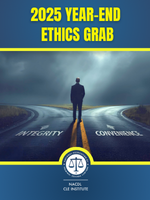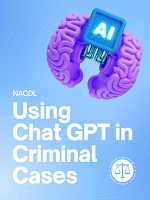Access to The Champion archive is one of many exclusive member benefits. It’s normally restricted to just NACDL members. However, this content, and others like it, is available to everyone in order to educate the public on why criminal justice reform is a necessity.
The day-to-day work of state-level criminal justice reform is supported by committed individuals and organizations including lawyers, judges, advocates, formerly incarcerated individuals, policymakers (on both sides of the aisle), and even district attorneys and members of the law enforcement community. The State Criminal Justice Network (SCJN) is comprised of a few of these entities. The following summaries provide a snapshot of the several criminal justice reforms that occurred in the 2010 legislative session in various states. It is a testament to the efforts and dedication of SCJN members who have provided a glimpse into the political wrangling, coalition-building and compromises that are part of the pursuit of legislative reform. This is part one of a two-part series of the amazing legislative efforts of Network members.
New York Prison-Based Gerrymandering
In 1998, the concept of “million dollar blocks” emerged when researchers in New York City identified several hot spot neighborhoods in which large numbers of former residents were in prison. Researchers called these neighborhoods “million dollar blocks” because so many residents were imprisoned — particularly in poverty stricken, high minority populated neighborhoods — that the cost of incarcerating them could be upwards of a million dollars or more. More often than not, courts sent individuals convicted to prisons in upstate New York and authorities counted them as residents of the community in which the facility was located rather than as residents of the communities from which they came.
In August 2010, the New York Legislature passed revenue bill A9710-D. As a result, all counties within the state of New York will now use the home address of incarcerated people, provided by the Department of Corrections, for the purpose of drawing legislative districts. Prior to this legislation, counties decided whether to count the prison population as residents of the district where the prisoners were incarcerated or as residents of the district where their homes were located. The core data is not being changed; instead, it is being counted using a different technique. Thirteen rural counties in New York already use this method to count the population, and all other counties will follow suit starting in 2011. In addition, Maryland and Delaware passed similar legislation last year. In Maryland the legislation passed unanimously in the House of Delegates.
According to Kate Rubin, the Director of Policy and Community Development at the Bronx Defenders, a coalition of community organizations and key lawmakers supported the New York bill. “Groups from around the state really came together,” she said. “It was a coalition of groups that traditionally worked on criminal justice issues including voting rights to people on parole, along with groups that traditionally work on good government and civic participation issues.” Despite opposition from some legislative districts in which prisons are housed, the bill gained momentum. The coalition worked strategically with allies in the legislature to pass the bill as part of the budget process, and ensured that it was signed by the governor. According to Rubin, “Former State Senator Schneiderman from Manhattan and Assemblymember Hakeem Jeffries from Brooklyn were the strongest forces for the bill, and the Black, Latino, and Asian Caucuses were crucial to moving the bill forward.” The new formula will ensure that fairly drawn and representative districts will be established. Redistricting will not affect federal funding distributions as federal funds go to states in the form of block grants. However, since prisoners will now be counted in the communities from which they come, there is a greater potential for more funding to be allocated to those communities.
‘Ban the Box’ Movements
Nearly 700,000 individuals per year leave prison to return to their communities. Studies prove that recidivism is less likely to occur when the individual is able to secure employment once released. However, being forced to admit a felony conviction in an employment application’s criminal history box is a detriment to formerly incarcerated individuals seeking to re-enter society and become productive members in their communities.
In an attempt to decrease recidivism and help released prisoners stand on their feet again, the District of Columbia government joined several other states including Hawaii, California, New Mexico, Minnesota, Rhode Island, Connecticut, Massachusetts, and New Mexico in passing a bill that eliminates the requirement that initial job applications request criminal history. However, due to the D.C. Home Rule Law, the bill must be approved by Congress.
If this bill passes, public employers, with some exceptions, will not be allowed to inquire into an individual’s criminal record before determining if the individual is qualified for an interview. Additionally, having a criminal record cannot be the sole determinant in making an individual ineligible for hire unless the employer can rightfully determine that the individual poses a danger to the D.C. government or people the individual will come into contact with as part of the individual’s employment responsibilities.
These reforms provide applicants with an opportunity to explain their criminal history and elaborate on whether or not it is relevant to prospective employment. While the employer makes the ultimate decision, the circumstances surrounding the criminal history are relevant and interviewees will now have a chance to prove their willingness and capability to fill the position.
Washington Crime Lab Oversight
In February 2009 the National Academies of Science (NAS) issued a report, Strengthening Forensic Science in the United States: A Path Forward, which set forth a roadmap for forensic evidence reform and renewed the call for fairness in the criminal justice system. In response to the NAS report, in February 2010 NACDL issued Principles and Recommendations to Strengthen Forensic Evidence and Its Presentation in the Courtroom, which provided additional recommendations for improvement within the justice system. Recently, several crime labs have been in the news due to discrepancies in lab results, leading to many cases being thrown out due to faulty evidence.
In the state of Washington, there was no defense attorney on the Forensic Investigations Council (FIC), the entity providing oversight of the state crime lab. The Washington State Bar joined forces with the Washington Association of Criminal Defense Lawyers (WACDL) to help rectify the problem.
Many labs, including Washington’s, receive federal grants and thus must have an independent body to oversee them and investigate any problems. As early as 2007, the Bar identified problems within the crime lab.
WACDL Executive Director Teresa Mathis organized a task force whose job was to work with lobbyist Bob Cooper to seek passage of SSB 6340, which provides for a defense bar seat on the FIC. After two legislative sessions, the efforts of the task force paid off with passage of the bill. Although SSB 6340 was a significant victory, the proposal to also add an independent scientist to the FIC fell by the wayside – largely due to budget concerns. The task force will work toward that goal in future sessions. Champions of the legislation included Sen. Debbie Regala, Rep. Sherry Appleton, Sen. Adam Kline, Rep. Roger Goodman (currently running for Congress), and Rep. Al O’Brien.
Rhode Island ID Task Force Bill
NACDL fought for years to secure access to data and other materials related to the Chicago Police Department’s controversial, taxpayer-funded report on lineups and eyewitness procedures. The report sets forth highly controversial and widely criticized conclusions that current eyewitness procedures — those that use traditional lineups where all suspects stand in a room together — are more effective than new procedures used in other American cities to reduce errors that can lead to wrongful convictions.
After seeking eyewitness ID reform for years, Rhode Island passed a bill that will establish a task force aimed at improving identification lineups. Mike DiLauro, Director of Training and Legislative Liaison for the Office of the Rhode Island Public Defender, and various allies worked diligently to get the bill passed. The task force will be comprised of a variety of experts who will bring their own individual experience and specialty together to consult with eyewitness identification practitioners and experts to craft guidelines for policies, procedure, and training.
The task force will be charged with establishing effective and consistent guidelines aimed at preventing errors that lead to wrongful convictions. The proper training of law enforcement officers will follow issuance of the guidelines.
Success finally came for the allies working on the legislation after decades of errors leading to wrongful convictions due to poor practices in how lineups are executed. “They came out of the woodwork,” said DiLauro, referring to legislators and officials that formerly opposed the bill but decided to support it in 2010, making it one of very few substantial bills that gained unanimous support. This reform changes the Rhode Island criminal justice system so that all of the districts will follow in the footsteps of Bristol, Cumberland, and Warwick in exercising proper practice. According to DiLauro, “Out of 42 law enforcement agencies, around 25 percent had a written policy and only three were exercising proper practice.” DiLauro emphasized that Attorney General Peter Kilmartin became a driving force in support of the reform. When asked what made the 2010 reform different from the past and how other states seeking similar reform could accomplish their goals, DiLauro’s answer was short and sweet: “Timing is everything.”
Michigan Drug Crime Parole Reform
In 1998 and 2002, Families Against Mandatory Minimums (FAMM) won sweeping reforms of the harshest drug laws in the nation — eliminating the mandatory minimums for drug offenses prospectively and providing early parole consideration for individuals convicted for offenses committed prior to the date the reforms became effective (March 1, 2003). As a result, hundreds of individuals were paroled years, sometimes decades, earlier. Largely touted as one of the most comprehensive pieces of reform on the state level, an evaluation of recidivism rates two years after the March 2003 reforms showed that the group of individuals who received early parole had a much lower recidivism rate than all others paroled in the same period. In addition, the percentage of the state prison population serving time for drug offenses declined steeply after the 2003 FAMM reforms, averting an impending bed space crisis.
Unfortunately, several hundred individuals did not obtain sufficient relief after the reform of Michigan drug laws, and they are still serving sentences under the harsh mandatory minimums. FAMM and the Criminal Defense Attorneys of Michigan (CDAM) have been working for several years to expand early parole eligibility provisions to those individuals.
HB 4918 and 4919 conform the statute with an earlier court decision providing individuals serving lifetime probation for offenses committed prior to March 1, 2003, parole eligibility after five years. HB 4920 provides earlier parole eligibility for individuals serving certain consecutive mandatory minimum sentences for low-level drug offenses committed prior to March 1, 2003. Unfortunately, provisions that would have made consecutive sentences concurrent for purposes of parole eligibility for some drug offenses were removed from the bill before passage, so there is more work to be done.
According to Laura Sager, who served as the Director of State Legislative Affairs at FAMM during the initial reforms, “The Michigan story shows that sweeping reforms are possible, but often the work takes years of determined effort to complete. Michigan has benefited from these reforms with no impact on public safety.”













